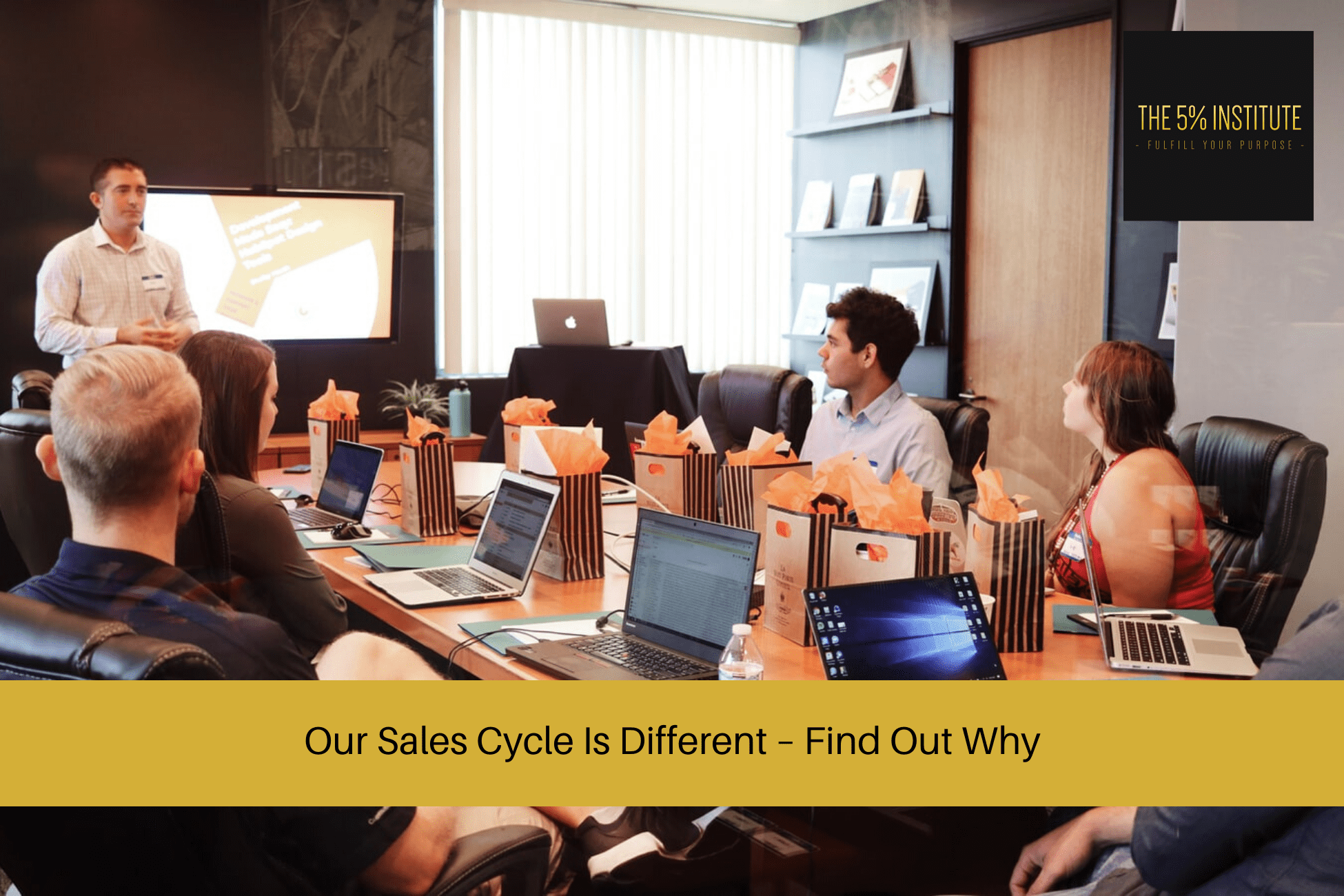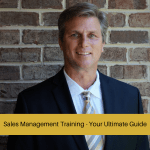
Our Sales Cycle Is Different – Find Out Why
Depending on your business model, your sales cycle will differ depending on the type of products or services that you sell.
However, industry and geography aside; is there a better sales cycle model to follow than the traditional model?
We believe so.
In this article, we’ll discuss:
- What is a sales cycle?
- The traditional steps of the sales cycle, and why it needs to improve
- Our recommendation so you can win more consistent sales
Our Sales Cycle Is Different – Find Our Why
What Is A Sales Cycle?
Similar to that of a sales process or sales framework; a sales cycle is the consistent steps needed for a Sales Professional or Business Owner to close new sales.
Not to be confused with a sales strategy – the sales cycle is the more on the ground, how to do tactics to turn interested potential clients into actual and happy ones.
Depending on your product or service type, your approach may change. For some potential clients, it may take months, and for others; one sales conversation could be enough.
The Traditional Sales Cycle Stages / Framework
The traditional sales cycle is one most commonly used by Sales Professionals and Business Owners.
It generally looks like this:
- Prospecting
- Connecting
- Research the client
- Present your offer
- Close
Other common sales cycle models include:
- Build rapport
- Present your offer
- Handle objections
- Ask for the sale
In our opinion, both these models are outdated and flawed, because when you present before you know exactly what you’re trying to solve; you’re playing a game of chance.
They’ll either believe you, or they won’t.
The old model of selling is to pitch or present to anybody that could potentially be a fit.
We call this ‘premature presentation’, and it damages your sales.
This older sales cycle model breaks trust with your potential clients, because it doesn’t allow you to deep dive into what it is they actually need solving, before you go into presentation mode.
When you go into presentation mode without learning what it is they need solved, you’re making the sale about you.
This makes your potential clients sceptical, as well as focuses your conversation around your own features and benefits.
Instead, we recommend using a new sales cycle model in which we’ll detail shortly.
Our Recommended Sales Cycle Model / Stages
At The 5% Institute, we teach that you should always separate yourself from the competition, by positioning yourself as a trusted advisor.
The way in which you could do this, is by prescribing a solution to their problems and pain points, rather than presenting and hoping something sticks.
In our online sales training program, The 5% Sales Blueprint; we teach a more modern and consultative sales cycle model, to help you earn trust, learn their pain points and desires – and then prescribe your product as the solution.
The steps of The 5% Sales Blueprint include:
- Prospecting
- Building rapport and qualifying
- Pre framing
- Asking questions that find pain
- Learning about their desires and ideal outcome
- Discussing money
- Presenting
- Handling objections, and asking for the sale
#1 – Prospecting
The first part of the sales cycle is finding out who your ideal prospects are, and then targeting them using prospecting strategies.
Prospecting can generally be two fold – inbound and outbound.
Inbound prospecting is putting together systems that drive traffic into your business.
Generally, it includes pay per click advertising, print media, SEO, and social media.
Outbound prospecting is proactively reaching out to your potential clients with social media, email, cold calling and networking events.
Related article: The Two Types Of Sales Prospecting
#2 – Building Rapport
The first part of any sales conversation, and next step in the sales cycle is building rapport with your potential clients.
Rapport us crucial if you wish to hold a consultative sales conversation with your potential clients.
It’s also important because people buy from people they like and trust.
By building rapport, you’ll be able to ask deep diving questions that can ultimately lead to a buying decision.
Related article: A Guide To Building Sales Rapport
#3 – Qualifying Your Potential Clients Early
The third part of the sales cycle is qualifying your potential clients early in the consultation or discovery call.
A lot of Sales Professionals and Business Owners make the error of speaking with people they think are potential clients – but end up not being qualified to either afford their product or service or aren’t the decision maker.
Qualifying early saves you time, energy, and money.
The qualifying framework to add to your sales cycle, is borrowed from an acronym called BANT.
Originally designed by IBM, it’s an easy to remember framework to remember what you need to ask to qualify your potential clients correctly.
BANT stands for:
- Budget
- Authority
- Need
- Time frame
Further reading: BANT In Sales – How Does It Work?
#4 – Pre Framing The Conversation
The fourth segment of the sales cycle is what makes our sales cycle very different from the others out there.
We teach something called a pre frame. This happens prior to your deep dive sales conversation.
The deep diving sales conversation you will have with your potential client, is called the frame.
You’ll have the opportunity to ask questions, and ‘frame the conversation’ in a way which will ultimately lead to a decision being made – either proceeding with a sale or deciding you may not be the right fit for one another.
The pre frame is the conversation you have prior to the frame; in this case, it is what’s discussed prior to going into your deep dive sales conversation.
During the pre frame, you want to cover three important things:
- Ensure all decision makers are present
- Let them know that you’ll be asking a lot of questions, to work out whether you can in fact help and serve them and their needs
- Give them comfort that at the end of the conversation, it is more than OK to say no if they’re not interested. Also let them know that many people use the “I need to think about it” as a way of covering for no. By giving them comfort, they’ll be more transparent.
The reason the pre frame is key, is for two reasons.
Firstly, you’re removing two core sales objections up front – the I need to think about it objection, and I need to speak to objection.
Secondly – you’re getting permission to ask deep diving questions, which is the next part of our sales cycle
Using a pre frame will be a game changer for your business and overall sales cycle, because you’ll get to the underlying truth faster than using a traditional sales methodology.
Related article: Positioning In Sales – How To Sell Effectively
#5 – Questions: The Key To A Successful Sales Cycle
The most important part of the sales cycle, as well as your overall ability to close more sales, – is the art of asking the right questions – and then diving deeper when you actively listen to their responses.
At The 5% Institute, we emphasise the importance of asking questions because we believe in using a consultative sales approach.
By asking the right questions – you’ll be able to help guide your potential client toward the sale and help them sell themselves on the need for a solution.
During your sales cycle, we recommend asking the following question examples:
- Finding pain
- Learning about their ideal outcome
- How they make buying decisions
- Why they’re speaking with you
- How long they’ve had their issue
We’ve written numerous articles on questioning and question categories, and recommend you read them to learn more. Check out the linked articles below to find out how.
- Sales Probing Questions
- Open Ended Sales Questions
- 10 x Questions To Ask A Potential Client
- 5 x Closing Questions To Win More Sales
Furthermore; if you’d like to learn about helping people sell themselves using questions, then we recommend learning about tie-down sales techniques.
Tie-down sales techniques are questions you ask that get an ‘agreed’ response.
Also known as trial closes – tie-down sales techniques help your potential clients sell themselves prior to having to ask for the sale.
Further reading: Tie-Down Sales Techniques – Your Ultimate Guide
An important note: finding pain is one of the most important ingredients for your questions and sales cycle.
This is because if you can’t find friction or any issues with their current situation – they won’t need to make a change.
The article below details how to do so effectively, without being pushy or breaking rapport.
Further reading: Pain Points & Sales – Your Ultimate Guide
#6 – Discussing Money
Discussing money is another important part of the sales cycle, because you can use the discussion to build monetary value around what a solution for their problem and pain points will mean.
When you’re discussing money, you ultimately want to understand two important things:
- What is it costing them by having these issues? Learn the financial and personal impact of what the pain points mean.
- How much would they pay to fix it, and have a solution?
Discussing this here makes asking for the sale, and your closing questions a breeze.
#7 – Presenting
Once money has been clearly discussed, the next stage of the sales cycle is presenting your solution.
As previously mentioned, many Sales Professionals handle presenting incorrectly and do something we call ‘premature presentation’.
As per our article in Entrepreneur, premature presentation is when you present your product or service prior to understanding what they need solved and hope that something you say sticks and resonates.
This spray and pray method are outdated and won’t help your closing rate.
Instead – when you’re presenting your product or service, we recommend you do so by prescribing it to their pain points and demonstrate how each of their problems will be solved with specific features and benefits you have.
Using a prescription approach as a specialist would, will align you as a trusted adviser, rather than just another salesperson trying to make a quick sale.
#8 – Handling Objections & Asking For The Sale
Finally, the last stage of the sales cycle is handling their areas of concern and asking for the sale.
Although many people advocate using word tracks and sales scripts, we recommend not using either.
Instead – we recommend using a simple and easy to remember objections framework.
The framework is:
- Listen carefully
- Repeat back the objection, and ask them to expand
- Validate the area of concern
- Re-frame the concern
- Confirm you’re on the same page
To learn how to do this in detail, read the article here to find out how.
Once you’ve handled all their areas of concern, simply ask if they’d like you to help them achieve what they intend to have solved and have them sign any agreements you may have in place.
Final Thoughts On The Sales Cycle
The sales cycle is one of the most important things to master in sales, because it’ll give you the process and framework to close more sales consistently.
Consistent sales are the key to success when selling; without consistency, you’ll continue to wing it, and your sales will be all over the place.
If you’re interested in learning more about closing consistently, you can register for our free 7 Day Sales Challenge here.
Want To Close Sales Easier?
Are you committed to closing sales a lot easier, and consistently?
If so, you should check out our self-paced and affordable online sales training program; The 5% Sales Blueprint.
It’ll give you everything you need to close sales consistently.
To learn more, simply click on the link below for more information.
Our Online Sales Training Program – The 5% Sales Blueprint.



